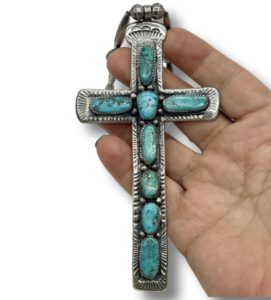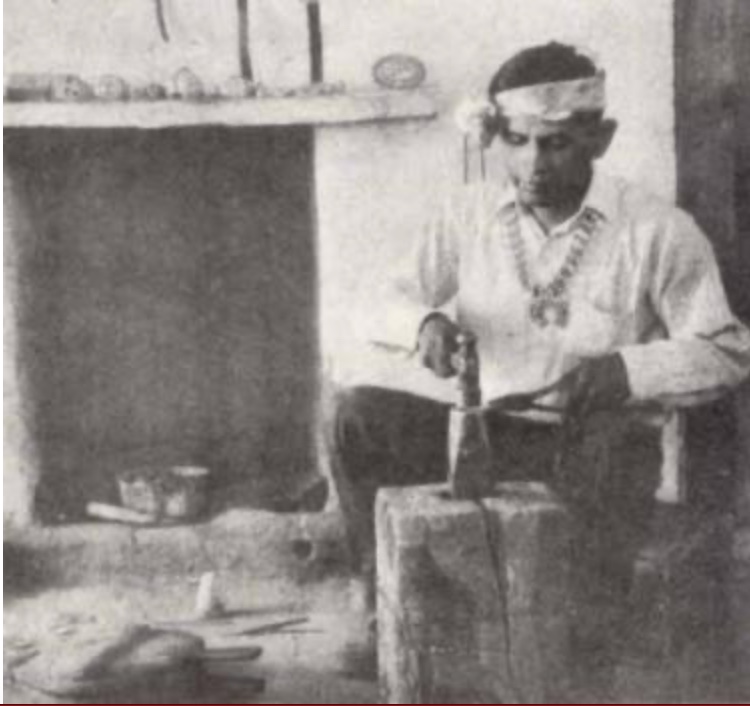The late Horace Iule (1901-1978) is one of the most famous Zuni Pueblo silversmiths. His work is featured in numerous books on Native American jewelry and displayed in museums and galleries across the United States. Iule is most well-known for his sand-cast jewelry, particularly crosses and Knifewing designs.
The Zuni artist was old-school in his methods and innovative in his business practices. He lived in a three-room house northwest of the plaza in Zuni, N.M. As seen working in the 1930s photo above, he used a short piece of railroad track attached to a tree stump as his anvil and carved his sand-cast molds out of stone. He blew air through a bellows over hot coal to melt his silver in a crucible. Then he poured it into his stone mold. The resulting pieces were stunning, one-of-a-kind treasures.

Iule was a third-generation Zuni jeweler; his grandfather known as “Sneezing Man” was one of the first silversmiths at the Zuni Pueblo dating back to the 1800s, according to author John Adair in his book, “The Navajo and Pueblo Silversmiths.”
Like many Native American youths of his generation, Iule in the early 1920s was sent to the Phoenix Indian School, which was a Bureau of Indian Affairs boarding school that attempted to assimilate Native American youth into Anglo society (a whole other story). When he returned to Zuni, N.M. he couldn’t find enough blacksmithing work, and so, his father taught him silversmithing.
Iule was a quick learner and industrious. It was the Great Depression, and so, it can be argued that he had to be. He not only made and sold jewelry, but he also taught silversmithing at the Zuni Day School and sold silversmithing tools that he made using his blacksmithing skills.
Casting His Own Path
In the early 20th Century, it was common in nearby Gallup, N.M. for traders to commission native silversmiths to make jewelry. Traders would supply some materials, and then only pay Native American artists in credit. Iule didn’t like that arrangement. He traveled to Gallup, N.M., purchased his own materials and sold his pieces to whomever he pleased.

Iule taught his wife Lupe silversmithing and together their work became highly sought by collectors. Historians credit Iule with being the first Zuni artist to put the Knifewing (half man, half eagle spirit) design to silver.
He worked into the 1970s and passed away in 1978. Horace’s art lives on in the generations of Native American artists he inspired and taught including those of his children: Wilbur Iule, Ruby Iule, Lupe Leekitty, Cecilia Iule, Robert Iule, Barney Iule, and Phillip Iule. Some of his other students include: son-in-law George Leekity, cousins Raymond Watson & Jerry Watson, David Tsikewa, Okweene Neese, Benny Hamona, Louie Waseta, Jack Weekoty, Annie Gasper, and his Zuni Day School students.

Sources and other readings:
Schaaf, George. “American Indian Jewelry I: 1,200 Artist Biographies
” CIAC Press, 2003.
Messier, Pat & Messier, Kim, “Reassessing Hallmarks of the Native Southwest Jewelry: Artists, Traders, Guilds and the Government” Schiffer Publishing, 2014


Great post!
Thanks!